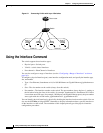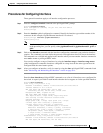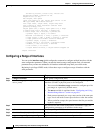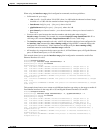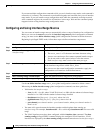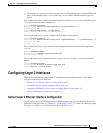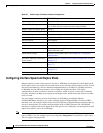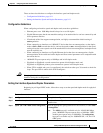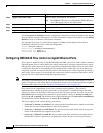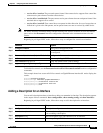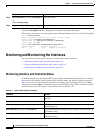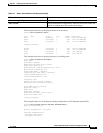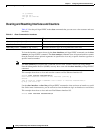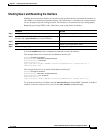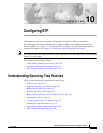
9-12
Catalyst 2950 Desktop Switch Software Configuration Guide
78-11380-05
Chapter 9 Configuring Interface Characteristics
Configuring Layer 2 Interfaces
Use the no speed and no duplex interface configuration commands to return the interface to the default
speed and duplex settings (autonegotiate). To return all interface settings to the defaults, use the default
interface interface-id interface configuration command.
This example shows how to set the interface speed to 10 Mbps and the duplex mode to half on
FastEthernet interface 0/3 and to verify the configuration:
Switch# configure terminal
Switch(config)# interface fastethernet0/3
Switch(config-if)# speed 10
Switch(config-if)# duplex half
Configuring IEEE 802.3X Flow Control on Gigabit Ethernet Ports
Flow control is supported only on 10/100/1000 Mbps and GBIC ports. Flow control enables connected
Gigabit Ethernet ports to control traffic rates during congestion by allowing congested nodes to pause
link operation at the other end. If one port experiences congestion and cannot receive any more traffic,
it notifies the other port to stop sending until the condition clears. When the local device detects any
congestion at its end, it can notify the link partner or the remote device of the congestion by sending a
pause frame. Upon receipt of a pause frame, the remote device stops sending any data packets, which
prevents any loss of data packets during the congestion period.
Note We strongly recommend that you do not configure IEEE 802.3X flowcontrol when quality of service
(QoS) is configured on the switch. Before configuring flowcontrol on an interface, make sure to return to
the default QoS settings listed in the “Default QoS Configuration” section on page 25-9.
Flow control can be implemented in two forms, symmetric and asymmetric. The symmetric
implementation is suitable for point-to-point links, and asymmetric is suitable for hub-to-end node
connections, where it is desirable for the hub to pause the end system, but not vice-versa. You use the
flowcontrol interface configuration command to set the interface’s ability to receive and send pause
frames to on, off, or desired. The default state for Gigabit Ethernet ports is receive off and send desired.
The default state for Fast Ethernet ports is receive off and send off.
These rules apply to flow control settings on the device:
• receive on (or desired) and send on: Flow control operates in both directions; both the local and the
remote devices can send pause frames to show link congestion.
• receive on (or desired) and send desired: The port can receive pause frames and can send pause
frames if the attached device supports flow control.
• receive on (or desired) and send off: The port cannot send pause frames but can operate with an
attached device that is required to or can send pause frames; the port can receive pause frames.
Step 4
duplex {auto | full | half} Enter the duplex parameter for the interface.
Note The 100BASE-FX ports set to 100 and the 10/100/1000 ports
set to 1000 operate only in full-duplex mode.
Step 5
end Return to privileged EXEC mode.
Step 6
show interfaces interface-id Display the interface speed and duplex mode configuration.
Step 7
copy running-config startup-config (Optional) Save your entries in the configuration file.
Command Purpose



